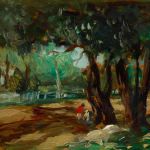-
Robert Henri 1865-1929
Central Park, c. 1901Oil on wood panel8 x 10 inches
(20.3 x 25.4 cm)
Framed dimensions: 13 1/2 x 15 1/2 inchesSigned lower left: Robert HenriSoldBorn Robert Henry Cozad, Robert shared a lineage with Mary Cassatt, making them cousins. Henri kept secret that relationship much as he did his birth name, in an effort to...Born Robert Henry Cozad, Robert shared a lineage with Mary Cassatt, making them cousins. Henri kept secret that relationship much as he did his birth name, in an effort to erase the reputation of a murder conviction against his father John Cozad. Robert's childhood reads like a Bret Harte short story. From card shark to real estate speculator, Henri's father moved the family from Cincinnati to Nebraska in a series of speculative land development projects. A disgruntled employee attacked Robert's father, and in self-defense his gun fired, killing the attacker. The murder conviction, later pardoned, led to the family's fleeing to Colorado, and assuming new identities. Robert Henri was sent to boarding school in New York, where he showed talent in writing and theater, creative endeavors encouraged by his mother. He discounted his creativity, thinking "artists surprised their parents... by doing masterpieces in their infancy... and [he] was not of that class" (Perlman). Nevertheless, painting buildings his father acquired in Atlantic City and producing political cartoons and color sketches for a small "museum" in his father's store caught the attention of admirers who encouraged Robert's art. James Albert Cathcart persuaded Henri to study at his alma mater, the Pennsylvania Academy of Fine Arts, where Henri enrolled in 1886.Robert Henri’s strong connection to the Pennsylvania Academy of the Fine Arts began when he enrolled as a student in 1886. He entered the Academy eight months after Thomas Eakins resigned under pressure from a scandal that broke out over his removal of a loincloth from a nude model. Despite Eakins’s absence, his strong influence on the curriculum at PAFA remained and it affected Henri profoundly. Eakins had instituted new educational policies at the Academy that were some of the most progressive in the country. Under his direction, students at the Academy learned to value realism and its application to distinctly American subjects. It was in this mode of instruction that Henri cultivated his own artistic style and philosophy.
Thomas Anshutz played an important role in Henri’s development as an artist. He upheld many of Eakins’s ideas and continued to build upon his teaching method; however, Anshutz was also open to change and cultivated individual artistic expression. A devoted teacher, he did not impose artistic formulas. Instead he encouraged his students’ idiosyncracies; he advocated close observation and a firm grasp of anatomy as the basis for good art; and he prompted his students to paint the world around them. Henri valued Anshutz’s criticism greatly, and determined to succeed as an artist, he worked tirelessly as his student.
After studying for three years in Paris from 1888 to 1891, Henri returned to Philadelphia and the halls of the Academy. With richer experience and increased confidence, he began to develop and promote the artistic philosophy that would come to define the remainder of his career. Steeped in Anshutz’s call for realism and plain painting without bravura, Henri challenged himself and the other artists he influenced to “paint what you feel . . . paint what is real to you.” And so began his lifelong pursuit of painting “life in the raw,” without what he deemed “academic artifice.” He promoted this credo to his many students and perhaps popularized it most in his sensational 1908 exhibition at Macbeth Gallery, where he and a group of artists, eventually called The Eight, mounted a show that was a direct affront to the National Academy of Design’s rejection of their work and the modernist spirit that shaped them as artists. Henri met four of the artists who made up The Eight, William Glackens, John Sloan, Everett Shinn, and George Luks, in Philadelphia, where they all took classes at PAFA.
Central Park, painted circa 1901, is an early example of Henri's commitment to paint the world around him as he saw it. Painted en plein air, Henri often executed these quick studies which were called pochades, small portable sketches that captured the color and atmosphere of a scene. This painting demonstrates Henri's fluid and spontaneous brushwork which depicts the luscious greenery of Central Park with a remarkable sense of energy and vitality.
Provenance
Hirschl & Adler Galleries, until 1960;
Private collection;
Private collection, New Jersey, until 2024
Please join our mailing list
* denotes required fields
We will process the personal data you have supplied in accordance with our privacy policy (available on request). You can unsubscribe or change your preferences at any time by clicking the link in our emails.



